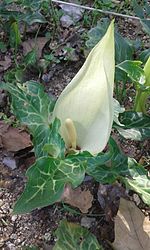Arum italicum
Arum italicum is a species of flowering herbaceous perennial plant in the family Araceae, also known as Italian arum and Italian lords-and-ladies.[2] It is native to the Mediterranean region (southern Europe, northern Africa, and the Middle East). It is also naturalized in Great Britain, the Netherlands, Crimea, Caucasus, Canary Islands, Madeira, Azores, Argentina and in scattered locations in the United States.[1][3][4][5][6][7]
| Arum italicum | |
|---|---|
 | |
| Scientific classification | |
| Kingdom: | Plantae |
| Clade: | Tracheophytes |
| Clade: | Angiosperms |
| Clade: | Monocots |
| Order: | Alismatales |
| Family: | Araceae |
| Genus: | Arum |
| Species: | A. italicum |
| Binomial name | |
| Arum italicum | |
| Synonyms[1] | |
| |
It grows 30–46 cm (1–1.5 ft) high, with equal spread. It blooms in spring with white flowers that turn to showy red fruit.[2] It is cultivated as an ornamental plant for traditional and woodland shade gardens.[2] Subspecies italicum (the one normally grown in horticulture) has distinctive pale veins on the leaves, whilst subspecies neglectum has faint pale veins, and the leaves may have dark spots.[8] Some gardeners use this arum to underplant with Hosta, as they produce foliage sequentially: when the Hosta withers away, the arum replaces it in early winter, maintaining ground-cover.[9] Numerous cultivars have been developed for garden use, of which A. italicum subsp. italicum 'Marmoratum' has gained the Royal Horticultural Society's Award of Garden Merit.[10]
Arum italicum can be invasive in some areas.[9][11]
Arum italicum may hybridize with Arum maculatum.[12]
In 1778, Lamarck noticed that the inflorescence of this plant produces heat.[13][14]
Leaves, fruits and rhizomes contain compounds that make them poisonous. Notably, leaves are rich in oxalic acid; other active principles are present in other parts. The ingestion of berries, which are showy and red, can be fatal for babies and young children, as well as dogs.
Gallery
 Bulbs
Bulbs Mature leaves
Mature leaves Spathe
Spathe Ripe berries
Ripe berries Botanical illustration
Botanical illustration Leaves of cultivar 'Marmoratum'
Leaves of cultivar 'Marmoratum'
Taxonomy
Within the genus, A. italicum belongs to subgenus Arum, section Arum.[15]
A. italicum generally has a chromosome count of 2n = 84, except that a few subspecies (such as ssp. albispathum have 2n = 56).[15]
References
- "Arum italicum". Integrated Taxonomic Information System. Retrieved September 25, 2006.
- Kew World Checklist of Selected Plant Families
- MBG- hort. . accessed 11.1.2011
- Altervista Flora Italiana, Pan di serpe, Large Cuckoo Pint, Italian Lords And Ladies, gouet d' Italie, flor de la primavera, jarro-dos-campos, Arum italicum Miller
- Govaerts, R. & Frodin, D.G. (2002). World Checklist and Bibliography of Araceae (and Acoraceae): 1-560. The Board of Trustees of the Royal Botanic Gardens, Kew.
- Castroviejo, S. & al. (eds.) (2008). Flora Iberica 18: 1-420. Real Jardín Botánico, CSIC, Madrid.
- Dobignard, D. & Chatelain, C. (2010). Index synonymique de la flore d'Afrique du nord 1: 1-455. Éditions des conservatoire et jardin botaniques, Genève.
- Biota of North America Program, 2013 county distribution map
- Taxonomy and Nomenclature in Some Species of the Genus Arum L, C T Prime, Watsonia 5 (2), 1961 pp 106-9
- Clark County Master Gardeners Archived July 5, 2015, at the Wayback Machine
- "RHS Plant Selector - Arum italicum subsp. italicum 'Marmoratum'". Retrieved 19 February 2020.
- National Park Service, Exotic Plant Management Team
- Plantsman v13:3, p142, September 2014; Royal Horticultural Society
- Meeuse, B.J.D. 1975. Films of liquid crystals as an aid in pollination studies. In Pollination and Dispersal, ed N.B.M. Brantjes, H.F. Linskens, pp 19-20. Nijmegen. The Netherlands: Dep. Botany, Univ. Nijmegen.
- Wilhelm Pfeffer, The Physiology of Plants: A Treatise Upon the Metabolism and ..., Volume 3
- Boyce, Peter (1993). The Genus Arum. London: HMSO. ISBN 0-11-250085-4.
External links
| Wikimedia Commons has media related to Arum italicum. |
- Missouri Botanical Garden - Kemper Center for Home Gardening - Arum italicum
- Invasive Plant Atlas Italian arum - Arum italicum